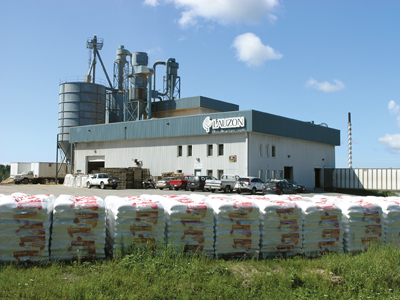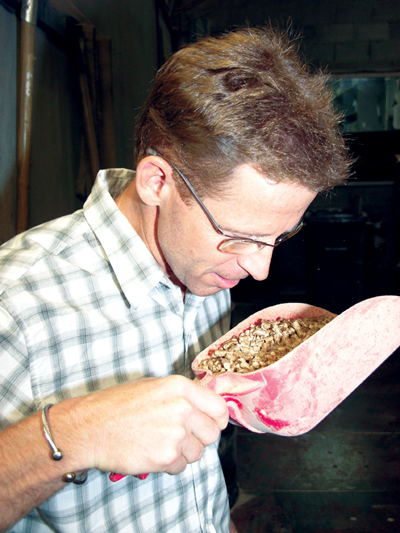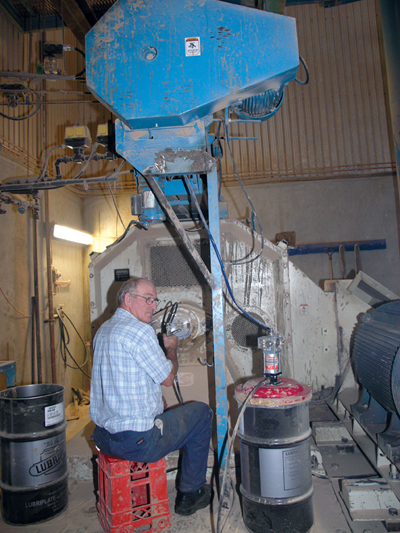
Lightweight Contender
May 27, 2009
By
Scott Jamieson
May 27, 2009 - When Lauzon Recycled Wood Energy (RWE) was founded over 12 years ago, the pellet market was in its infancy in North America. There were few Canadian players, and markets were just forming.
When Lauzon Recycled Wood Energy (RWE) was founded over 12 years ago, the pellet market was in its infancy in North America. There were few Canadian players, and markets were just forming. More than a response to a burgeoning market demand, Lauzon RWE was a way for the main business, Lauzon Flooring (now Lauzon International Inc. – LII), to solve a messy problem.
 |
|
| The Lauzon Recycled Wood Energy pellet mill in Papineauville, QC with pallets of Cubex brand pellets in the foreground, and the two Rodair sawdust silos at left.
|
“The flooring plant down the hill was already creating the dry raw material a pellet mill needs,” explains sales and marketing director Stewart McIntosh. “This was a key, and they had an abundance of it at the time, which had to be land filled at a cost. There were few developed opportunities in the energy market at the time, so pellets were the way to go. Appliances to burn pellets were only coming on the market domestically, but we had a need here, so we went ahead.”
What started out as a $2.5 million investment in helping the company’s state-of-the-art hardwood flooring plant out of a jam has since developed into an environmentally-responsible business of its own, and one with a growing future. Demand has always been hard to predict in the young pellet market, but it too seems to be coming of age. For this coming season at least markets will not be an issue, not judging by the large storage yard adjacent to the mill. All but a tiny corner was empty when Canadian Biomass was on site in August. “It’s normally jammed this time of year, and we’re sold out of appliances this year too,” McIntosh adds of the Harman pellet stoves the company also represents.
Steady Supply
What hasn’t changed since those early days is the direct flow of fibre from the successful flooring plant to the pellet company. The automated and optimized flooring plant has a host of machine centres producing dust and shavings, including chop saws, rip saws, and sanding lines. This fibre is collected by a dust collection system and blown up the hill to the pellet mill, making up 70% of the annual need. The other 30% comes in on truck from local wood products plants, and is dumped onto a screw infeed pad. The company runs upwards of 80 trucks to keep the flow of raw materials in and finished goods out.
 |
|
| Sales and marketing director Stewart McIntosh enjoys the aroma from some oak pellets, good for BBQs as well as heating.
|
Both fibre sources merge in two storage silos – 40 and 80 ton units. It is screened, sized in hammer mills, and then blown into a holding bin above the pellet mill. Material goes to the one and only pelletizer the plant runs – a warhorse that almost never stops, McIntosh says. “We’re talking production efficiencies of 98%.”
It also runs 24/7, explaining the mill’s relatively high production numbers. From here, pellets drop down to a cooling system in the basement, and are brought back up to a 40-ton bin that feeds a Hamer automated bagging system. The company markets under three brand names, so product is bagged according to market. Bags then continue to a new robotic palletizing system supplied by Quebec-based Robovic. Canadian customers are supplied to the tune of 75 bags per pallet, while US clients get 50 per pallet, the latter largely to accommodate shipping restrictions between both countries. Shipping is via truck, with the plant located 45 minutes from Ottawa and an hour from Montreal.
Safety has been a hot topic of late in the pellet sector, but Lauzon has been covered on this front since it opened in 1995. “We have a Flamex spark and fire detection system. If material goes through the hammer mill, and the system detects a spark, it’ll shut the system down. If it detects heat, we have a flood gate that will flood the system.”
It’s a wise investment for any pellet plant to make. According to Flamex, the risk of dust fires and explosions is inherent in the pneumatic handling and air filtration processes found in any wood products manufacturing facilities, and wood pellets is no exception, as it involves processes such as drying and hammer milling which are particularly conducive to the generation of sparks and fire. The Flamex system as supplied to Lauzon by Rodrigue Metal detects airborne sparks traveling through a pneumatic duct, and suppresses them with water before they can reach cyclones, baghouses or dust bins where fires and even explosions could result. The water spray stops automatically when suppression has been achieved so production can continue and costly downtime can be avoided. Lauzon is certainly out front in taking such risks seriously – In addition to the Papineauville and St. Paulin facilities, Rodrigue Metal has also supplied Flamex systems to Lauzon plants located in St. Norbert and Manawaki.
The Papineauville plant also runs a quality control room, where among other things, key QC parameters are verified every two hours. These include moisture content (target of 6%), ash content (0.4% or less depending on species), dust content and particle size.
Almost all production is sold in central Canada and the northeastern US, 98% of it in bags for residential heating in pellet stoves. While the company has tried selling in bulk to Europe, it found the risks outweighed the benefits. “We’ve learned from it. If we go back into Europe in the future, we’ll do things differently, but for now with our location and production, we can sell our products domestically (US and Canada).”
More Growth Ahead
The Papineauville pellet operation runs with eight people in administration, although this group also shares some responsibility for the company’s other pellet mill in St. Paulin, east of Montreal. The Papineauville mill relies on 16 plant employees to run 24/7, while the St. Paulin plant adds two more administrators and 14 to 16 on the floor for another 25 tons/year or so. While the two plants have a combined capacity of close to 75,000 tons, they have more typically produced 60,000 tons/year. Like most pellet plants, inconsistent markets, supply shortages, and plant inefficiencies have combined to limit production well below capacity.
 |
|
| A solitary pellet mill makes the plant’s 35,000 tons annually, and is maintained to run 24/7. |
“Markets have been a year-to-year challenge. Compared to any other energy source, domestic pellet use and pricing have been a flat line with a few bumps. There’s lots of potential, but it’s still a young industry. We’ve had shortages in the past, which scares people just as they start thinking of using pellets. There’s more talk of that this year again, even with the new plants coming on line. Then we’ll have a mild winter, and supply outstrips demand.”
Yet the company is currently planning on some sustained growth, and has recently been staffing up to prepare for it. For example, McIntosh had until recently been general manager, handling both sales and production. He now focuses 100% on sales, with Pierre Tremblay handling operations. Part of this growth is expected to come from the St. Paulin plant, which was shut down in April 08 for a major rebuild. It originally ran with three pellet mills – two small and one large. The two small units are being replaced with a larger one, for efficiency and added production.
“We started off with a two-phase project, and were going to do the first $750,000 phase this year. With the market, we’ve decided to do it all in one go, and are investing $1.5 million this year to bring it up to a state-of-the-art facility, with computer controls, fire suppression, automated packaging – the works.”
“It’s fair to say we see this as a growth market,” McIntosh concludes.
| Growth, but for what? Lauzon Recycled Wood Energy has several projects in the works or in action to boost its annual pellet output, but where will these extra pellets end up? Sales and marketing director Stewart McIntosh sees incremental growth in the domestic market as fossil fuel costs rise over time. Still, it’s not likely to boom over night, he cautions, as North America lacks the residential heating appliances and delivery infrastructure required for pellet heating to go mainstream. “You need the ease of use they have in Europe. The appliances and support are coming, and the drive is on to develop that market, but it will be a slow development.” Aside from residential pellet stove heating, there is also potential for industrial and greenhouse heating, markets that are both growing. The latter especially has been all the talk at greenhouse industry meetings, as owners struggle with heating costs that have soared from 15% of overall costs to 40% or higher. And then there are the really big potential players, like Ontario Power Generation (OPG). At the recent CANBIO annual conference in Ottawa this past October, Jane Todd of OPG’s fossil fuel division announced that its biomass co-firing trials have been exceeding all expectations. The goal is to replace all or a portion of the coal it currently uses for a large part of its power generation needs. OPG has been running co-firing trials at its four coal-fired plants, including four hours of using 100% biomass at its Atikokan facility, and various levels at North America’s largest coal-fired power plant in Nanticoke, ON. According to Todd, the trials have been much more successful than even OPG’s best-case expectations, with both power generation and emission standards more than acceptable. Building on this success, and an aggressive provincial policy to phase out coal by 2014, OPG plans to quickly ramp up biomass firing, and is talking of 100% conversion at Atikokan, which currently uses a lower-quality lignite coal and has direct rail access. The fuel of choice is wood pellets, as they allow the utility to use existing assets, such as pulverisers, with a minimum of modifications. The target announced at the meeting is 2.5 terawatts, which if our math is right (600,000 tons of pellets per TW) requires 1.5 million tons of high quality pellets. For an idea of the effect this power giant could have on the solid bioenergy market, Canada currently produces slightly more than 2 million tons/year. If the economics and politics work out, OPG could create a biomass support industry all its own. And Lauzon’s expansion plans, even if they all move forward, would be a drop in the bucket. |
|
Print this page